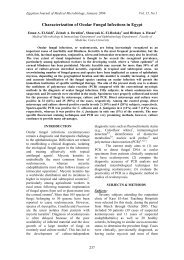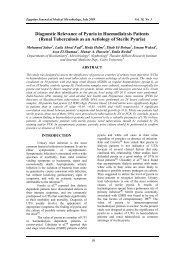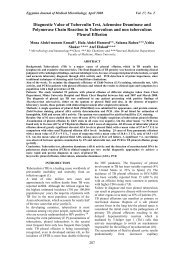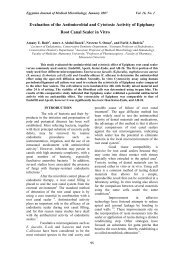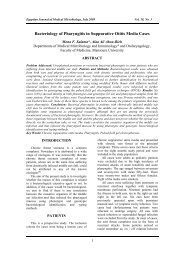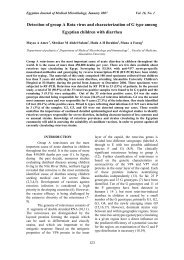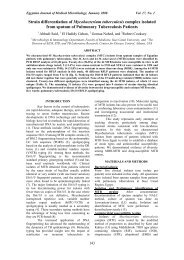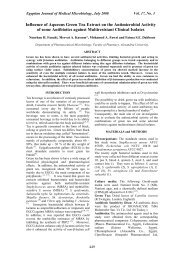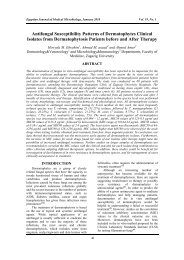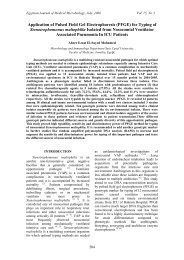Chromagar Staph aureus Versus Blood Agar and Mannitol Salt Agar ...
Chromagar Staph aureus Versus Blood Agar and Mannitol Salt Agar ...
Chromagar Staph aureus Versus Blood Agar and Mannitol Salt Agar ...
You also want an ePaper? Increase the reach of your titles
YUMPU automatically turns print PDFs into web optimized ePapers that Google loves.
Egyptian Journal of Medical Microbiology, January 2007 Vol. 16, No. 1<strong>Chromagar</strong> <strong>Staph</strong> <strong>aureus</strong> <strong>Versus</strong> <strong>Blood</strong> <strong>Agar</strong> <strong>and</strong> <strong>Mannitol</strong> <strong>Salt</strong> <strong>Agar</strong>for Isolation <strong>and</strong> Identification of <strong>Staph</strong>ylococcus <strong>aureus</strong> fromSuppurative Skin LesionsWafaa M.K.Bakr <strong>and</strong> Heba S.SelimMicrobiology Department, High Institute of Public Health, Alex<strong>and</strong>ria University<strong>Chromagar</strong> <strong>Staph</strong> <strong>aureus</strong> (CHROMagar Company, Paris, France) is a chromogenic agar mediumproposed for the detection of <strong>Staph</strong>ylococcus <strong>aureus</strong> by incorporation of a chromatic substrate intoa suitable isolation medium <strong>and</strong> then detection of the activities of a specific bacterial enzymes bycolor changes thus eliminating the need for time consuming <strong>and</strong> costly biochemical identification.To evaluate this medium, a total of 105 suppurative skin lesion swabs were cultured ontoCHROMagar <strong>Staph</strong> <strong>aureus</strong> agar, blood agar (gold st<strong>and</strong>ard) <strong>and</strong> mannitol salt agar. After 24 h ofincubation a total of 83 S. <strong>aureus</strong> strains were recovered on blood agar. <strong>Chromagar</strong> <strong>Staph</strong> <strong>aureus</strong>succeded to isolate 82 strains with mauve color in the first 24 h with a sensitivity of 98.79 % <strong>and</strong> aspecificity of 95.45 % ,with no further isolation after extending the incubation time to 48 h. Asregards mannitol salt agar, 43 (51.8%) strains were recovered as yellow colonies after 24 h ofincubation compared with 61(73.4%) strains after incubation for 48 h. These results wereassociated with a sensitivity of 50.60% after 24 reaching up to 73.49% after 48 h. We conclude thatCHROMagar <strong>Staph</strong> <strong>aureus</strong> compared favorably to conventional media for rapid detection ofS. <strong>aureus</strong> in clinical samples <strong>and</strong> achieved a higher sensitivity <strong>and</strong> specificity than mannitol saltagar for the isolation <strong>and</strong> presumptive identification of S. <strong>aureus</strong> from suppurative skin lesions .Key words:<strong>Chromagar</strong> <strong>Staph</strong> <strong>aureus</strong> , <strong>Blood</strong> <strong>Agar</strong> ,<strong>Mannitol</strong> <strong>Salt</strong> <strong>Agar</strong> , <strong>Staph</strong>ylococcus <strong>aureus</strong>INTRODUCTION<strong>Staph</strong>ylococcus <strong>aureus</strong> (S. <strong>aureus</strong> ) is animportant <strong>and</strong> frequent cause of of skin <strong>and</strong>soft tissue infection <strong>and</strong> is consequently oneof the most common pathogens sought inclinical microbiology laboratories. (1) Reliable<strong>and</strong> rapid methods to identify these organismsare crucial in any clinical laboratory. (2,3)Diagnosis of S. <strong>aureus</strong> skin infectionis generally performed by culture of swabsonto nonspecific media <strong>and</strong> confirmation ofsuspected colonies by biochemical <strong>and</strong>/orserological tests. (4)Most commonly, this involves testingcolonies of staphylococci for the coagulationof plasma, the fermentation of mannitol(mannitol salt agar [MSA]), the production ofthermostable nuclease (DNase), egg yolklipase hydrolysis (lipovitellin-salt-mannitolagar [LSM]), <strong>and</strong> the production of naturalpigment. (2,3,5)Colonies of S. <strong>aureus</strong> may be atypical<strong>and</strong> difficult to differentiate from coagulasenegativestaphylococci ,a large number ofagglutination tests may be required to rule outthe presence of S. <strong>aureus</strong>. (6)A number of culture media have beendeveloped to increase the specificity of S.<strong>aureus</strong> detection, including mannitol-salt agar<strong>and</strong> Baird-Parker medium. (7,8)A more recent approach has been theuse of CHROMagar <strong>Staph</strong> <strong>aureus</strong>, whichemploys chromogenic enzyme substrates in aselective agar medium, allowing the detectionof S. <strong>aureus</strong> with a high degree of sensitivity<strong>and</strong> specificity. (9)The present study examines the use ofa chromogenic plate medium, CHROMagar<strong>Staph</strong> <strong>aureus</strong> (CAS), <strong>and</strong> <strong>Mannitol</strong> <strong>Salt</strong> <strong>Agar</strong>(MSA) versus the gold st<strong>and</strong>ard <strong>Blood</strong> agar(BA) for the isolation <strong>and</strong> identification ofS. <strong>aureus</strong> from pyoderma (suppurative skinlesions).The criteria for medium evaluationincluded colony growth reaction, colorreproducibility for the identification ofS. aureu.MATERIAL AND METHODSCulture media.CHROMagar <strong>Staph</strong> <strong>aureus</strong> wasprovided by the CHROMagar Company,Paris, France. The medium contained agar(15 g/liter), peptones (40 g/liter), NaCl(25 g/liter), <strong>and</strong> a proprietary chromogenicmix (3.5 g/liter). The medium was prepared asinstructed by the manufacturer by avoidingheating at over 100°C. Columbia blood agar63
Egyptian Journal of Medical Microbiology, January 2007 Vol. 16, No. 1base (Acumedia, Baltimore, Md.)supplemented with 5% human blood (bloodagar) <strong>and</strong> mannitol-salt agar (Oxoid-CM85),were prepared according to the manufacturer'sinstructions.Clinical samples:Suppurative skin lesions of a total of105 pyoderma patients admitted to theoutpatient clinic of the Main UniversityHospital, Alex<strong>and</strong>ria, Egypt, were included inthis study. Swabs were used to collectsuppurative exudates from skin lesions, thenimmediately delivered to the lab forprocessing. Each swab was inoculated <strong>and</strong>spread onto each of the three types of media(BA, MSA <strong>and</strong> CAS). All plates wereaerobically incubated at 37°C, BA for 24 h (10), CAS for 48 h (according to manufacturerinstructions) <strong>and</strong> MSA for 48 h. (10)Identification of S. <strong>aureus</strong>.Golden yellow hemolytic or nonhemolytic colonies on blood agar, yellowmannitol fermenting colonies on MSA <strong>and</strong>mauve colonies on CAS were regarded aspresumptive S. <strong>aureus</strong> <strong>and</strong> were confirmedwith Gram stain reactions, reactions tocatalase (3% [wt/vol] hydrogen peroxide,reactions to slide <strong>and</strong> tube coagulase (rabbitplasma), <strong>and</strong> DNase activity were used foridentification. (10) RESULTSEighty three confirmed strains of S.<strong>aureus</strong> were isolated (from 105 swabs takenfrom suppurative skin lesions) on one or moreagar culture media within 48 h of incubation.A total of 83 strains were isolated onBA after 24 h of incubation.On CSA, 83 strains were recovered asmauve colonies after 24 h <strong>and</strong> no furthergrowth was detected after incubation for 48 h.One of these mauve colony was not provedto be S. <strong>aureus</strong> (false positive). These resultswere associated with sensitivity of 98.79 %<strong>and</strong> a specificity of 95.45 %. (Table 1)As regards MSA, 43 strains wererecovered as yellow colonies after 24 h ofincubation compared with 62 strains afterincubation for 48 h. One yellow colony wasnot proved to be S. <strong>aureus</strong> (false positive).These results were associated with asensitivity of 50.60% <strong>and</strong> 73.49 % after 24<strong>and</strong> 48 h. respectively. (Table 2, 3)Table 1: • <strong>Chromagar</strong> <strong>Staph</strong> <strong>aureus</strong> versus blood agar for detection of S. <strong>aureus</strong> after 24incubation hours.<strong>Blood</strong> agar<strong>Chromagar</strong>totalpositivenegativepositive 82 1 83negative 1 21 22total 83 22 105•After extending incubation to 48 hours mauve color of colonies start to fade away in most ofthe platesSensitivity = T+ve/T+ve+F-ve = 82/82+1= 98.79%Specificity = T-ve / T-ve+F+ve = 21/21+1= 95.45%Table 2: <strong>Mannitol</strong> salt agar versus blood agar for detection of S. <strong>aureus</strong> after 24incubation hours.Bl.agarMSAtotalpositivenegativepositive 42 41 83negative 1 21 22total 43 62 105Sensitivity = 42/42+41 = 50.60%Specificity = 21/21+1= 95.45%64
Egyptian Journal of Medical Microbiology, January 2007 Vol. 16, No. 1Table 3: <strong>Mannitol</strong> salt agar versus blood agar for detection of S. <strong>aureus</strong> after 48incubation hours.<strong>Blood</strong> agarMSAtotalpositivenegativepositive 61 22 83negative 1 21 22total 62 43 105Sensitivity = 61/61+22= 73.49%Specificity = 21/21+1= 95.45%DISCUSSIONIsolation of S. <strong>aureus</strong> is usuallyaccomplished with the use of conventionalmedia such as blood agar. The disadvantageof such media is the need of confirmatorytests to differentiate S. <strong>aureus</strong> from colonieswith identical colony appearance or whenswarming colonies of Proteus cover those ofS. <strong>aureus</strong> on such ordinary media. (2)Performing such tests on all coloniesresembling staphylococci can be timeconsuming<strong>and</strong> labor intensive. (8,11)The use of chromogenic media canpotentially reduce the number of confirmatorytests that are necessary for the detection of S.<strong>aureus</strong>. (4,8)The ideal characteristics of anyc<strong>and</strong>idate chromogenic medium are thedetection of S. <strong>aureus</strong> with high specificity<strong>and</strong> an isolation rate at least comparable toconventional media after 18 to 20 h ofincubation. (4,8)In this study, CAS was highlysensitive (98.79%) for S. <strong>aureus</strong>, where itsucceeded to detect 82 out of the total 83 S.<strong>aureus</strong> strains after 24 h incubation. The samesensitivity (98.5%) was obtained by Carricajoet al., (11) 2001; <strong>and</strong> a near results wereobtained by Gaillot et al., (8) 95.5%, 2000,Perry et al., (4) 96.2% , 2003,<strong>and</strong> D’Souza etal., (12) 69%, 2005. Slightly higher sensitivity(99.5%) was obtained by Flyhart et al. (13) ,2004.In the present study sensitivity ofCAS did not increase with extending theincubation time to 48 h, in the contrary itdecreased, as the mauve color of somecolonies faded away. The same result wasreported by Kluytmans et al., (14) who reportedthat after 48 h the sensitivity of CAS wasslightly lower.In contrast, D’Souza <strong>and</strong> Baron., (12)reported that the sensitivity of CAS afterovernight incubation was 82% <strong>and</strong> increasedto 96% after additional 24 h incubation.<strong>Mannitol</strong>-salt agar (MSA) is one ofthe most widely used selective media forisolation of S. <strong>aureus</strong>. It consists of mannitolto indicate the presence of S. <strong>aureus</strong> <strong>and</strong> avariable concentration of sodium chloride toinhibit the growth of other microorganisms. (15)In the present study MSA had a lowsensitivity of 73.49%, in contrast to thereports of other authors who reported asensitivity reaching up to 96% <strong>and</strong> 97.1%respectively. (12,14)The low sensitivity of MSA in this study wasdue to the high false negative rate which wecould not find an explanation to, except thatthese strains might be inhibited by the highsalt component of this medium. (16)MSA showed a sensitivity of 50.60%after 24 h incubation which markedlyincreased to 73.49% after further 24 h. Thisseems to be consistent with the findings ofD’Souza <strong>and</strong> Baron (12) who mentioned thatthe sensitivity of MSA increased from 71%after 24 h to 96% after extending theincubation to another 24 h.In conclusion, CSA comparedfavorably to conventional media for rapiddetection of S. <strong>aureus</strong> in clinical samples <strong>and</strong>achieved a higher sensitivity <strong>and</strong> specificitythan MSA for the isolation <strong>and</strong> presumptiveidentification of S. <strong>aureus</strong> from suppurativeskin lesions .The use of CSA is much less laborintensive than conventional methods <strong>and</strong>requires fewer reagents for confirmation ofsuspect colonies of S. <strong>aureus</strong>. (12,17)Sometimes, strains which wereconsidered positive after 24 h were negativeafter 48 h. This may be due to variability in65
Egyptian Journal of Medical Microbiology, January 2007 Vol. 16, No. 1the interpretation of the observer or to a truediscoloration after prolonged incubation.Whatever the cause may be, we recommendreading CSA plates after 24 h, as this gives amore accurate result. (13)The cost of CSA is higher than that ofnonselective conventional media. However,there is some efficiency gained with the useof this medium. The more rapid visualizationof the specific mauve pigmentation ofS. <strong>aureus</strong> allows working through culturesmore quickly; therefore, slide coagulase testscan be substantially reduced or eliminated.Additional biochemical tests or identificationmethods that may be needed on occasion forfinal identification can also be reduced oreliminated. Moreover, there is no need tosubculture organisms for antimicrobialsusceptibility testing. (13)The cost of selective media such asMSA is higher than that of nonselectivemedia. The additional costs incurred with theuse of the MSA <strong>and</strong> required subcultureplates, slide coagulase, <strong>and</strong> additionalbiochemical tests narrow the cost differential<strong>and</strong> make the change from a selectivemedium to CSA closer to cost-neutral. (12,13)So we recommend the use of CSAagar medium for the isolation <strong>and</strong> the specificidentification of S.<strong>aureus</strong> from pyodermalsuppurative skin lesions.REFERENCES1. Paule SM, Pasquariello AC, Hacek DM,Adrienne G. Fisher AG, ThomsonRB,Kaul KL, Peterson LR. Directdetection of <strong>Staph</strong>ylococcus <strong>aureus</strong> fromadult <strong>and</strong> neonate nasal swab specimensusing real-time polymerase chainreaction. JMD 2004; 6(3):191-203.2. Philppe P, Michele B, Ger<strong>and</strong> L,V<strong>and</strong>enesch F, Brun Y, Etienne J E.Comparative performances of sixagglutination kits assessed by usingtypical <strong>and</strong> atypical strains of<strong>Staph</strong>ylococcus <strong>aureus</strong>. J Clin Microbiol1997; 35:1138-40.3. Griethuysen V, Bes M, Etienne J,Zbinden R, Kluytmans J. Internationalmulticenter evaluation of latexagglutination tests for identification of<strong>Staph</strong>ylococcus <strong>aureus</strong>. J Clin Microbiol2001; 39:86-9.4. Perry JD, Rennison C, Butterworth LA,Hopley ALJ, F. Gould K. Evaluation ofS. <strong>aureus</strong> ID, a New Chromogenic <strong>Agar</strong>Medium for Detection of <strong>Staph</strong>ylococcus<strong>aureus</strong>. J Clin Microbiol 2003; 41:5695-8.5. Merlino J, Leroi M, Bradbury R, VealD, Harbour C. New chromogenicidentification <strong>and</strong> detection of<strong>Staph</strong>ylococcus <strong>aureus</strong> <strong>and</strong> methicillinresistantS. <strong>aureus</strong>. J Clin Microbiol2000; 38:2378-80.6. Baumert N, Eiff CV, Schaaff F, PetersSG, Proctor RA, Sahl HG. Physiology<strong>and</strong> antibiotic susceptibility of<strong>Staph</strong>ylococcus <strong>aureus</strong> small colonyvariants. Microb Drug Resist 2002;8:253-60.7. Baird R M, Lee WH. Media used in thedetection <strong>and</strong> enumeration of<strong>Staph</strong>ylococcus <strong>aureus</strong>. Int J FoodMicrobiol 1995; 26:15-24.8. Gaillot O, Wetsch M, Fortineau N,Berche P. Evaluation of CHROMagar<strong>Staph</strong>. <strong>aureus</strong>, a new chromogenicmedium, for isolation <strong>and</strong> presumptiveidentification of <strong>Staph</strong>ylococcus <strong>aureus</strong>from human clinical specimens. J ClinMicrobiol 2000; 38:1587-91.9. Göran H , Fang H. Evaluation of TwoNew Chromogenic Media, CHROMagarMRSA <strong>and</strong> S. <strong>aureus</strong> ID, for Identifying<strong>Staph</strong>ylococcus <strong>aureus</strong> <strong>and</strong> ScreeningMethicillin-Resistant S. <strong>aureus</strong>. J ClinMicrobiol 2005; 34:4242-4.10. Kloose WE, Bannerman TL.<strong>Staph</strong>ylococcus <strong>and</strong> Micrococcus. In:Murray PR, Baron EJ, Pfaller MA,Tenover FC, Yoken RH (editors).Manual of clinical MICROBIOLOGY.6 th ed. Washington DC: Americansociety for Microbiology; 1995.p.282-98.11. Carricajo A, Treny A, Fonsale N, BesM, Reverdy M, Gille Y,et al,. Aubert,<strong>and</strong> A. M. Freydiere. Performance of thechromogenic medium CHROMagar<strong>Staph</strong> <strong>aureus</strong> <strong>and</strong> the <strong>Staph</strong>ychromcoagulase test in the detection <strong>and</strong>identification of <strong>Staph</strong>ylococcus <strong>aureus</strong>in clinical specimens. J Clin Microbiol2001; 39:2581-3.12. D’Souza HA,Baron EJ. BBLCHROMaga <strong>Staph</strong> <strong>aureus</strong> is superior tomannitol salt for detection of<strong>Staph</strong>ylococcus <strong>aureus</strong> in complex66
Egyptian Journal of Medical Microbiology, January 2007 Vol. 16, No. 1mixed infections .Am J Clin Pathol,2005; 123(6):806-8.13. Flayhart D, Lema C, Borek A, CarrollKC.Comparison of the BBL <strong>Chromagar</strong><strong>Staph</strong> <strong>aureus</strong> agar medium toconventional media for detection of<strong>Staph</strong>ylococcus <strong>aureus</strong> in respiratorysamples. J Clin Microbiol 2004; 42:3566-9.14. Kluytmans J, Griethuysen VA, WillemseP, Keulen PV. Performance ofCHROMagar selective medium <strong>and</strong>oxacillin resistance screening agar basefor identifying <strong>Staph</strong>ylococcus <strong>aureus</strong><strong>and</strong> detecting methicillin resistance. JClin Microbiol 2002;40:2480-82.15. Gorss EB. 1995. Prospective, focusedsurveillance for oxacillin-resistant<strong>Staph</strong>ylococcus <strong>aureus</strong>. In: Isenberg HD(ed.). Clinical microbiology proceduresh<strong>and</strong>book. ASM Press, Washington,D.C. 1995. p. 11.15.1-216. Jones EM, Bowker KE, Cooke R,Marshall RJ, Reeves DS, MacGowanAP. <strong>Salt</strong> tolerance of EMRSA-16 <strong>and</strong> itseffect on the sensitivity of screeningcultures. J Hosp Infect 1997; 35:59-62.17. Apfalter P, Assadian O, Kalczyk A,Lindenmann V, Makristathis A, MustafaS ,et al. Performance of a newchromogenic oxacillin resistance screenmedium (Oxoid) in the detection <strong>and</strong>presumptive identification of methicillinresistant<strong>Staph</strong>ylococcus <strong>aureus</strong>. DiagnMicrobiol Infect Dis 2002; 44:209-1167



